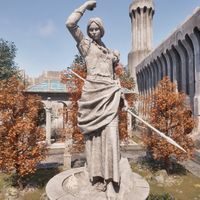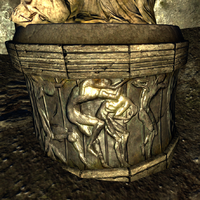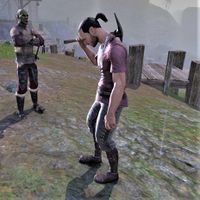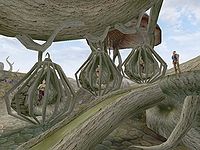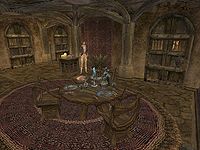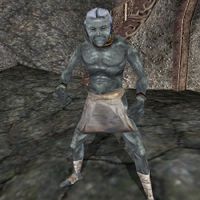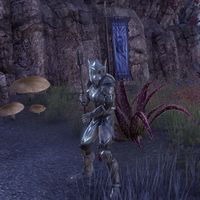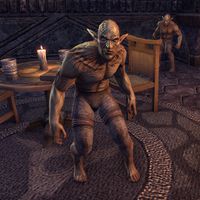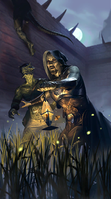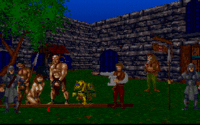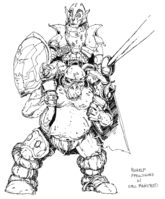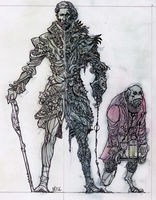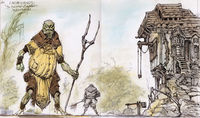Lore:Slavery
This is neither fair nor right, and should be resisted as violently as possible, everywhere and at all times. Anyone who stands idly by and lets another be enslaved is no better than the one who cracks the whip." —A Free Argonian's Manifesto
Slavery is the practice of owning an individual as property. It was once widespread throughout Tamriel, ranging from the practice of using defeated enemies as slaves, selling one's own children to combat hunger, or invading land specifically to capture slaves, as the Dunmer long did to Black Marsh. The enslavement of men, Orcs, and beastfolk by elven races was traditionally permitted.
Origins[edit]
Slavery has existed on Tamriel since the Early Merethic Era, when the Aldmer arrived on the Summerset Isles and enslaved the native goblins.[1][2] The slave trade has existed since at least the early First Era, when the Chimer grandmaster Thalthil Dres' raid on Thorn secured the trade for his house.[3][4] Akaviri slavetraders plagued Tamriel by the hundreds in the First Era, but they were destroyed by the machinations of folk-hero Lyrisius and have not threatened Tamriel since.[5]
Slavery by Practitioning Race[edit]
Altmer[edit]
The High Elves are known for enslaving goblins,[6] using them for menial tasks such as mucking out dung pits and cleaning floors. Often being beaten by their elven owners, this has been known to give the goblins forms of mental trauma with escaped goblins still sweeping and being frightened of others.[7] Goblins have also been used traditionally by the Altmer to supplement their armies.[8] They use other goblin-ken as slaves as well, such as ogres and gremlins.[9] The High Elves have also been noted to enslave members of other elven races, such as Orcs and the Dunmer Ulvul Llaren.[9][10]
Argonian[edit]
The Archeins are a tribe of Argonians infamous for their kleptocracy.[11] They were often embezzling money and power to themselves at the expense of their race. Some of these examples include selling other Argonians into slavery for the Dunmer[12] or exploiting their land for foreign interest, such as the Empire.[13]
To help with the building of their city, Mazzatun the Argonian tribe of Xit-Xaht often captured people for months. The Xit-Xaht rarely talked next to those prisoners, but the members of the tribe were noticed to never stop moving, as they pointed and whipped as if they were mad, with one of the captives believing that the tribe would turn feral without the guidance of their leader.[14]
Ayleid[edit]
The Ayleids started their long history with slavery when they conquered the Eight Islands, taking the native bird men[16] as slaves and making use of their literacy.[17] According to legend, after Shezarr mysteriously vanished from Cyrodiil during the Merethic Era, the Ayleids were able to conquer and enslave the local Nedes.[18] At first, their capture was occasional, but it grew systematic and widespread.[19][20] In Shadowfen, the Barsaebic Ayleids captured Argonians as slaves, prizing their resilience.[21] The Ayleids also took Duraki slaves in Craglorn, but the specifics of the period are unknown, with later Duraki architecture displaying little to no Ayleid trace.[22]
Ayleid slavery was cruel and reviled. To honor the Princes, the Daedra-worshipping Daedraphile clans tortured the Nedes, with the practice of flesh-sculpture and gut-gardening becoming a particularly widespread form of "art".[20][19] Specific implements of art-torture, used upon slaves for strange pleasures, included the wailing wheels of Vindasel and the gut-gardens of Sercen. In the city-state of Fire King Hadhuul, slave children were incinerated for sport, and others were forced to inhale drugs, giving them visions of unseen torment. Some tribes of Nedes were completely wiped out by these religious practices, such as the men-of-ge, who were sacrificed by Flower King Nilichi to an insect god. Slaves were often dehumanized, unable to keep family or choose a name.[20]
Led by Slave-Queen Alessia, the enslaved Nedes rose against the Ayleids in the Alessian Slave Rebellion circa 1E 242.[18] Some city-states of the Ayleid Empire opposed slavery and assisted the Alessians in their revolt, although the resulting economic transition to a slave-less economy was wrenching.[23][24] The rebellion was ultimately successful, toppling the Ayleid Empire one year later in 1E 243. Though the now-free Alessians led the new empire, it is inconclusive whether slavery ever ended under their rule. The cultural perception of the Ayleids as brutal slavemasters persisted for centuries after their extinction.[25] Indeed, the revulsion for Daedra worship that pervades most human cultures in Tamriel probably originated from the treatment of Nedic slaves by the Daedraphiles in the Late Merethic.[19]
Bosmer[edit]
Tribal Bosmer have the custom of the "Mourning War". After the war-time death of a tribe member, the clan responsible for their death is raided for captives. Typically only one, but if the deceased was of notable importance multiple hostages may be taken. These captives serve as "replacements" for the slain Bosmer and are physically tortured for an extensive period of time. When finally mentally broken, the hostages are instead happily welcomed into the clan and mentally bewildered by this sudden change of behavior, submitting to their torturers. Typically, they're also given the possessions, position and family of the Wood Elf they're replacing, though in modern times this is less common.[26]
Breton[edit]
Bretons have typically been on the receiving end of slavery, and had their origins as a race by being progenated by generations of Elven intermingling and slavery.[27] Despite this, during the era of the High Rock coin-barons, slavery was a fact of life for Bretons.[UOL 1] The island of Amenos was a stronghold for slavers from High Rock, though by the time of High King Emeric this was no longer the case.[28][29] However, some Bretons still practiced slavery during his reign, such as House Velmont in Hew's Bane,[30][31] and bandit groups such as the Red Rooks.[32]
Dragon[edit]
After migrating to Skyrim from Atmora, the Dragon Cult became increasingly strict.[33] Those who resisted the influence of the cult became the slaves of the iron-fisted Dragon Priests,[34] the underlings of the Dragons themselves. In Valthume, the domain of Hevnoraak, citizens would be tortured and humiliated.[35] Thousands died in the rebellion against the Dragon Cult, in which some Dragons betrayed Alduin after seeing his tyranny.[36]
Dreugh[edit]
According to the teachings of Mankar Camoran, "the Mundex Terrene was once ruled over solely by the tyrant dreugh-kings, each to their own dominion, and borderwars fought between their slave oceans... No one that lived did so outside of the sufferance of the dreughs." This lasted until Lyg was destroyed by Mehrunes Dagon, and he declared "each of the nineteen and nine and nine oceans Free."[37]
Dunmer[edit]

Most slaves in Morrowind were beastfolk, such as Khajiit, Imga, and Orcs, with Argonians being the most commonly kept slaves. The Dunmer historically considered all beastpeoples and humans to be mere "animals", and as such "no more than domesticated chattels".[39] Since the advent of the Third Era, slavery was illegal throughout the Empire, but protected by law in Morrowind. This exception was granted by Tiber Septim in the Armistice of 2E 896 as a concession to the Dunmer, who saw the use of slaves as their ancient right. Recent developments have seen the rise of abolitionists such as the Twin Lamps, often with support from members of the leading families on Vvardenfell. Slavery remained legal in Morrowind throughout the lifespan of the Third Empire, provoking strong reactions on both sides.[40][41][42] It was only by Imperial times that the Dunmer reluctantly acknowledged humans as people, with many Dunmer at the end of the Third Era avoiding keeping human slaves of any nation so as to not offend humans, although slaves with Nordic features were common the province's north.[39]
- "We are disappointed that the Imperial Cult does not speak out against the inhumane practices of slavery in Morrowind. But perhaps you are right. It is by demonstrating our superior commitment to civilization and humanity that we best disprove the Dunmer's barbaric insistence that we are no more than animals." —Im-Kilaya, Head of the Argonian Mission in Ebonheart
House Dres thrived on mass abduction of Argonians and Khajiit into slavery, often with the support of local rival warlords selling their own kind.[43] Dres families worked Argonian slaves on large saltrice plantations on the southeast coast of Morrowind, while others profited from the slave trade itself.[3] They held thousands in their infamous slave-pens of Tear, to be shipped by smugglers to cave holding pens on the Bitter Coast. The plantations of House Hlaalu nobles made widespread use of slaves as farm labor. In comparison, slavery was uncommon among the members of House Redoran, though some of their warriors used slaves, pitting them against beasts for entertainment.[44][citation needed- source for Redoran involvement?] House Telvanni used slaves as servants for housework and as labor in mines. Towns like Molag Mar, Suran and Tel Aruhn had regular slave markets.
In the aftermath of the Vvardenfell Crisis, there were a few rebellious landowners who attempted to eliminate slavery in their lands. Some were murdered by their slaves, some were sabotaged and ruined by their House, and others were driven into poverty until they had no option but to sell their land to their neighbors who still kept slaves.[UOL 2] In a shrewd political maneuver, King Helseth, representing his own house of Hlaalu, formed an alliance with House Dres. Subsequently, he renounced the slave trade in 3E 430,[UOL 3] setting the remaining Houses of Indoril and Redoran against him in a bloody civil war.[citation needed] Helseth emerged from the war battered, but without the loss of his essential powers, leaving the Morrowind slave trade generally destroyed.[45]
Dwemer[edit]
After their defeat at the hands of the invading Atmorans during The Return, particularly at the Battle of the Moesring,[46] many Snow Elves across Skyrim were forced to accept an offer of sanctuary from the Dwemer. As per the terms of their stay, the elves consumed a toxic fungus that rendered them blind. At first, they were servants, but eventually, the Snow Elves became slaves.[47] Additionally, the Rourken Clan of Dwemer conquered Craglorn after their exodus of Resdayn, enslaving the local Duraki, using the Nedes' labor in their settlements. The Duraki seemed to respect the Dwarves' mastery of stonework, requesting burial amidst their ruins[48] and utilizing their techniques in a crude way for their own structures.[22]
The Snow Elves were herded into slave pens,[49] where they were subjected to torture at the hands of the Dwemer.[50] In Irkngthand, the enslaved mer were forced to build their Great Statue in secret, tricking their masters into believing they had confiscated the Eyes of the Falmer.[51] After generations of enslavement, the Snow Elves rebelled against the Dwarves, managing to temporarily overthrow them and take refuge in Blackreach's deepest caverns. The ensuing War of the Crag raged bitterly for years, until 1E 700,[52] when the Dwemer race vanished from Tamriel.[47] Over time, the once-proud race degraded both mentally and physically, becoming known as the Falmer.[53]
Falmer[edit]
According to legend, the Falmer emerge from their caverns in the dead of night to capture infants.[47] They have been known to take captives from the surface.[54] Within the Silent City of Blackreach, the Falmer own slaves who act as guards and lookouts.[55] They also use slaves for mining work.[56]
Imperial[edit]
During and after Queen Euraxia Tharn's invasion of Elsweyr, the Empire purchased slaves from Sea Elf privateers. Queen Euraxia used clever loopholes to avoid the workers being considered slaves by law, but the truth was clear.[57] The slaves were forced to mine for new ores in the desert.[58] After the Battle of Pale Pass, the Second Empire kept Tsaesci slaves which played a significant part in establishing the administrative structures of the Empire, as well as in the training of its military.[59] Tiber Septim's army sold captive Bretons into slavery after the Battle of Sancre Tor.[60] In the Third Era, using ogres for slave labor was legal in Cyrodiil.[61]
When the Imperial Legion took over Cheydinhal during the Three Banners War, they turned its people into slaves and forced them to work solely to feed them, while leaving little else for themselves.[62] Young men were forcefully extracted from their homes and recruited into their ranks. When one commoner named Donus Falto fled the town, it sparked the rebellion between the Imperials and the people.[62][63]
Ka Po' Tun[edit]
The Ka Po' Tun have, at one point, attempted to enslave the Tang Mo. However, with the rise of Tosh Raka, the two races became allies.[64]
Kamal[edit]
The Kamal have, at one point, attempted to enslave the Tang Mo.[64]
Khajiit[edit]
The Thazahrr Cartel is a slavery organization founded by the Khajiit Thazahrr-ra. It is based in Abah's Landing in southern Hammerfell and handles the slave industry in the region. Only a few Khajiit make up its ranks as the group is also comprised of Imperials, Bretons, and Redguards. By 2E 582, Thazahrr Goldfang was the sixth person to take the name and rank of Merchant Lord in the cartel. When the Shadow Conglomerate emerged in power, the cartel lost prominence, something that Thazahrr Goldfang hoped to reclaim and in turn, acquire the same honorific as her ancestor.[65] In the same year, Khajiiti pirates raided Deshaan for Argonian slaves.[66][67]
Maormer[edit]
The Maormer are no strangers to piracy and slavery, selling slaves to the Imperials[58] and using distinctive manacles unique to their race.[68] They were reported to use Snake Magic to influence the minds of their captives and ensorcelled locks when capturing slaves to ensure that they remained docile and compliant.[69]
Nord[edit]
The City of Kings was built by Snow Elf slaves of the Nords.[70] In the Fourth Era, the Silver-Blood family's prison, Cidhna Mine, utilized the slavery of criminals and captured Forsworn soldiers for use in mining silver.[71][72]
Orc[edit]
The Orcs believe that in the afterlife every wife has a thousand slaves catering to their every whim.[73]
Reachfolk[edit]
As a fractured society, each of the Reachfolk Clans has its own set of rules and policies. Certain clans,[74] such as Crow-Wives,[75] Dreadhorns,[76] and Thornroots were known for keeping slaves and captives. This was not a practice accepted by many other clans, such as Hillhunters.[77][78][79] Freedom was considered to be of great importance in the Reach.[80] Ard Caddach of Markarth offered food, freedom, and protection to all his subjects,[81] former captives of the other clans were free in Markarth.[82] Wayward Guardians were known to detest captivity and slavery, "not wishing a fate like that on anyone."[83]
Redguard[edit]
The waves of Ra Gada who fled the sinking of Yokuda, enslaved many of the native Beastfolk and Nedes of Hammerfell.[84] Specifically the Duraki, the Nedes of Craglorn, were conquered and enslaved by the Anka-Ra, who deemed them a backward people deserving of nothing more.[22]
Sload[edit]
Sload merchants are known to purchase large quantities of slaves from Tear. It is suspected that they bring them to their native Thras for usage in Necromancy.[85]
Snow Elf[edit]
According to Nordic account, during the snow elven raid on Saarthal, the elves took slaves from the human population. They reasoned that the Bretons, after generations of intermingling with elves, were the descendants of these slaves,[27] but this is disputed.[86]
Tsaesci[edit]
The Tsaesci have attempted, at one point, to enslave the Tang Mo. Additionally, they successfully enslaved the goblins of their nearby islands, using them for labor and for blood, which they consume for their vampiric satiation. They similarly enslaved the Red Dragons after an attempt to "consume" them,[64] going on to use them as war mounts.[59]
Gallery[edit]
Cyrus freeing Khajiit slaves from a House Dres camp
(The Origin of Cyrus!)A sketch of a House Dres slaver near the Black Marsh border drawn by ¥R
Notes[edit]
- The Nerevarine once purchased a slave from Tel Aruhn to earn the faith of the Zainab Tribe of Ashlanders.[87]
- Various pieces of concept art for Shivering Isles depict Grummites being used as indentured servants.
- Ken Rolston, the lead designer of Morrowind, compared the slavery in the game to the Roman Empire's methods of slavery rather than more contemporary instances.[UOL 4]
See Also[edit]
- For game-specific information, see the Morrowind article.
References[edit]
- ^ Auridon Explored, Chapter XII — Fenlil the Wayfarer
- ^ Toothmaul Gully loading screen in ESO
- ^ a b Understanding House Dres — Solamar Dres, Grand Historian for the House
- ^ Dres Grandmaster Memorial Medal treasure description in ESO
- ^ The Story of Lyrisius — Bresne Smythe
- ^ Goblin-Sized Weighted Shackles item description in ESO
- ^ Byz's dialogue in ESO
- ^ Fedris Hler's dialogue in Morrowind: Tribunal
- ^ a b Pocket Guide to the Empire, 1st Edition: The Wild Regions — Imperial Geographical Society, 2E 864
- ^ Light Armor Forging — Revus Sarvani
- ^ The Argonian Account, Book 4 — Waughin Jarth
- ^ Freedom's Price
- ^ Pocket Guide to the Empire, 3rd Edition: The War with the Trees: Argonia and the Black Marsh — Imperial Geographical Society, 3E 432
- ^ Captive's Journal
- ^ The Song of Pelinal, v 2
- ^ Father Of The Niben — Florin Jaliil
- ^ Decentius Opsius' dialogue in Oblivion
- ^ a b Shezarr and the Divines — Faustillus Junius
- ^ a b c Daedra Worship: The Ayleids — Phrastus of Elinhir
- ^ a b c The Adabal-a — Morihaus
- ^ Dialogue between Ayleid Scholars in ESO
- ^ a b c Nedes of the Deathlands — Argus Mender
- ^ A Life of Strife and Struggle — King Laloriaran Dynar
- ^ King Laloriaran Dynar's dialogue in ESO
- ^ The Last King of the Ayleids — Herminia Cinna
- ^ War Customs of the Tribal Bosmer — Mistral Aurelian Teriscor
- ^ a b Pocket Guide to the Empire, 1st Edition: High Rock — Imperial Geographical Society, 2E 864
- ^ High King Emeric's dialogue in ESO: High Isle
- ^ Mara's Tear — Zhen
- ^ Walks-Softly's dialogue in ESO: Thieves Guild
- ^ Anais Velmont's dialogue in ESO: Thieves Guild
- ^ Enslaved Miners in ESO
- ^ The Dragon War — Torhal Bjorik
- ^ Yvara Plouff's dialogue in ESO: Greymoor
- ^ Valdar's dialogue in Skyrim
- ^ Paarthurnax's dialogue in Skyrim
- ^ Mythic Dawn Commentaries — Mankar Camoran
- ^ Jhaka's dialogue in ESO
- ^ a b People of Morrowind — Various
- ^ Brown Book of 3E 426
- ^ The Eastern Provinces
- ^ For my Gods and Emperor — Imperial Cult
- ^ The Argonian Account — Waughin Jarth
- ^ Radiant Conversations in Oblivion
- ^ Pocket Guide to the Empire, 3rd Edition: The Temple: Morrowind — Imperial Geographical Society, 3E 432
- ^ The Betrayed — Engwe Emeloth
- ^ a b c The Falmer: A Study — Ursa Uthrax
- ^ Erold's dialogue in ESO
- ^ Irkngthand Slave Pens appearance and name in Skyrim
- ^ Karliah's dialogue in Skyrim
- ^ Thief's Last Words
- ^ Dwemer Inquiries Vol I — Thelwe Ghelein, Scholar
- ^ Knight-Paladin Gelebor's dialogue in Skyrim: Dawnguard
- ^ Alone in the Dark quest in ESO
- ^ Appearance and behavior of Falmer Servants in Skyrim
- ^ Appearance and behavior of Blackreach Thralls in ESO: Greymoor
- ^ Abnur Tharn's dialogue in ESO: Elsweyr
- ^ a b Jahhouz's dialogue in ESO: Blackwood
- ^ a b Pocket Guide to the Empire, 1st Edition: Cyrodiil — Imperial Geographical Society, 2E 864
- ^ Battle of Sancre Tor
- ^ Lord Drad's dialogue in Oblivion
- ^ a b Vyctoria Girien's dialogue in ESO
- ^ Tertius Falto's dialogue in ESO
- ^ a b c Mysterious Akavir
- ^ Abah's Landing Merchant Lords, V. 4 — Tamonir, Master of Secrets for the Queen of Taneth
- ^ Events of The Ravaged Village in ESO
- ^ Events of The Saving of Silent Mire in ESO
- ^ Maormer Slave Manacles item description in ESO
- ^ Coiled Serpent Lock antiquity codex entry in ESO
- ^ Songs of the Return, Vol 19
- ^ Dialogue between Enmon and Belchimac in Skyrim
- ^ Madanach's dialogue in Skyrim
- ^ On Orcs and the Afterlife — Erisa Moorcroft, Scholar, Comparative Religious Studies
- ^ Ask Us Anything: Variety Pack 4
- ^ A Life Barbaric and Brutal — Arthenice Belloq
- ^ Filand's dialogue in ESO
- ^ Events of Betrayal at Briar Rock in ESO
- ^ Bralthahawn's dialogue in ESO
- ^ Medone's dialogue in ESO
- ^ Arana's dialogue in ESO
- ^ Ard Caddach's dialogue in ESO
- ^ Kjaggus' dialogue in ESO
- ^ Ardanir's dialogue in ESO
- ^ Pocket Guide to the Empire, 1st Edition: Hammerfell — Imperial Geographical Society, 2E 864
- ^ Corpse Preparation v I
- ^ The Bretons: Mongrels or Paragons? — Phrastus of Elinhir
- ^ Events of Zainab Nerevarine in Morrowind
Note: The following references are considered to be unofficial sources. They are included to round off this article and may not be authoritative or conclusive.
- ^ Twitch Stream of High Isle Dev Discussion, time stamp 1:19:32-1:20:20
- ^ Ted Peterson's posts in High Rock Highjinks
- ^ Ted Peterson's posts in Playing Houses
- ^ Ken Rolston's Posts

